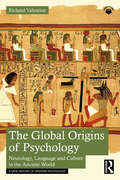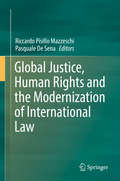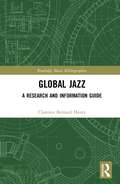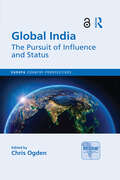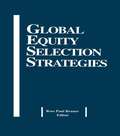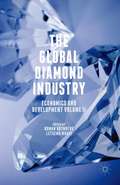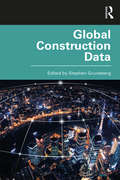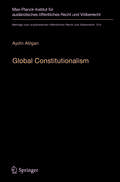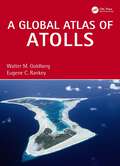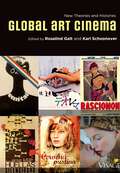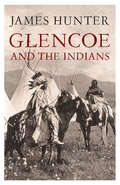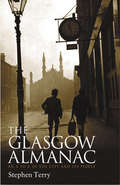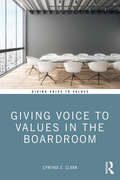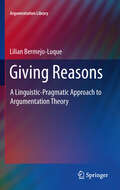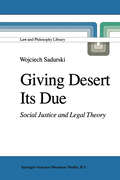- Table View
- List View
The Global Origins of Psychology: Neurology, Language and Culture in the Ancient World (A New History of Western Psychology)
by Richard ValentineThis book offers a historical introduction to the remote origins of psychology, and is the first book in a series on the history of the subject. Combining a deep history approach with the study of ancient civilisations, it places psychology in a historical and global context using rigorous academic research. This book begins by separating the Greek components of psychology – psyche and logos – in order to trace their histories, separate and together, through the global Neolithic and Bronze Ages. The author develops a toolkit by deconstructing the writing of history, modern psychology, and analysis of culture, and by introducing theories from neuroscience and cultural psychology that can be tested against the data. He then takes readers on a journey back in time, from the borders of our current climatic envelope (the Holocene) towards the present, through Ancient Iraq, Egypt, Israel, and China. Each chapter deepens the reader’s understanding of psychology in its global context outside the boundaries of Western culture. In so doing, the book initiates a post-colonial re-narration showing that the story of psychology is wider and deeper than many contemporary origin stories suggest. Presented in an accessible manner, this is an excellent resource for students of psychology, philosophy, history, linguistics, archaeology, and anthropology, as well as general readers who want to learn more about the origins of this fascinating subject.
The Global Origins of Psychology: Neurology, Language and Culture in the Ancient World (A New History of Western Psychology)
by Richard ValentineThis book offers a historical introduction to the remote origins of psychology, and is the first book in a series on the history of the subject. Combining a deep history approach with the study of ancient civilisations, it places psychology in a historical and global context using rigorous academic research. This book begins by separating the Greek components of psychology – psyche and logos – in order to trace their histories, separate and together, through the global Neolithic and Bronze Ages. The author develops a toolkit by deconstructing the writing of history, modern psychology, and analysis of culture, and by introducing theories from neuroscience and cultural psychology that can be tested against the data. He then takes readers on a journey back in time, from the borders of our current climatic envelope (the Holocene) towards the present, through Ancient Iraq, Egypt, Israel, and China. Each chapter deepens the reader’s understanding of psychology in its global context outside the boundaries of Western culture. In so doing, the book initiates a post-colonial re-narration showing that the story of psychology is wider and deeper than many contemporary origin stories suggest. Presented in an accessible manner, this is an excellent resource for students of psychology, philosophy, history, linguistics, archaeology, and anthropology, as well as general readers who want to learn more about the origins of this fascinating subject.
Global Organized Crime: A Reference Handbook (Contemporary World Issues)
by Mitchel P. RothThis book offers a comprehensive, multidimensional look into the major activities, groups, causes, and policing strategies related to global organized crime.Global Organized Crime: A Reference Handbook examines global organized crime dating back to its 17th-century roots. Unlike most works on the subject, which take a parochial approach by concentrating on individual countries or regions, this book uniquely details the impact of 21st-century globalization on such groups and their activities.Exploring the continuum of international organized crime and related developments from its early beginnings to the present era, the book also looks at the complicated issues that continue to influence its growth. It covers the impact of the end of the Cold War, immigration, the global drug trade, weapons sales, human smuggling and trafficking, the convergence of funding sources, and the effects of technology. What especially distinguishes this book is the connections it makes between organized crime activities and failed states, civil wars, political transitions, regional conflicts, and terrorist groups.
Global Organized Crime: A Reference Handbook (Contemporary World Issues)
by Mitchel P. RothThis book offers a comprehensive, multidimensional look into the major activities, groups, causes, and policing strategies related to global organized crime.Global Organized Crime: A Reference Handbook examines global organized crime dating back to its 17th-century roots. Unlike most works on the subject, which take a parochial approach by concentrating on individual countries or regions, this book uniquely details the impact of 21st-century globalization on such groups and their activities.Exploring the continuum of international organized crime and related developments from its early beginnings to the present era, the book also looks at the complicated issues that continue to influence its growth. It covers the impact of the end of the Cold War, immigration, the global drug trade, weapons sales, human smuggling and trafficking, the convergence of funding sources, and the effects of technology. What especially distinguishes this book is the connections it makes between organized crime activities and failed states, civil wars, political transitions, regional conflicts, and terrorist groups.
Global Justice, Human Rights and the Modernization of International Law
by Riccardo Pisillo Mazzeschi Pasquale De SenaThis book is based on the observation that international law is undergoing a process of change and modernization, driven by many factors, among which the affirmation and consolidation of the role of the individual and of the theory of human rights stand out. In the contemporary world, international law has demonstrated an ability to evolve rapidly. But it is still unclear whether its modernization process is also producing structural changes, which affect the subjects, the sources and even the very purpose of this law. Is it truly possible to speak of a paradigmatic and ideological change in the international legal system, one that also involves a transition from a state-centred international order to a human-centred one, and from inter-state justice to global justice?The book addresses three fundamental aspects of the modernization process of international law: the possible widening of the concept of international community and of the classic assumptions of statehood; the possible diversification of the sources of general international law; and the ability of international law to adapt to new challenges and to achieve the main goals for humanity set by the United Nations.The overall objective of the book is to provide the tools for a deeper understanding of the transition phase of contemporary international law, by examining the major problems that characterize this phase. The book will also stimulate critical reflection on the future prospects of international law.
Global Jazz: A Research and Information Guide (Routledge Music Bibliographies)
by Clarence Bernard HenryGlobal Jazz: A Research and Information Guide is an annotated bibliography that explores the global impact of jazz, detailing the evolution of the African American musical tradition as it has been absorbed, transformed, and expanded across the world’s historical, political, and social landscapes. With more than 1,300 annotated entries, this vast compilation covers a broad range of subjects, people, and geographic regions as they relate to interdisciplinary research in jazz studies. The result is a vivid demonstration of how cultures from every corner of the globe have situated jazz—often regarded as America’s classical music—within and beyond their own musical traditions, creating new artistic forms in the process. Global Jazz: A Research and Information Guide presents jazz as a common musical language in a global landscape of diverse artistic expression.
Global Jazz: A Research and Information Guide (Routledge Music Bibliographies)
by Clarence Bernard HenryGlobal Jazz: A Research and Information Guide is an annotated bibliography that explores the global impact of jazz, detailing the evolution of the African American musical tradition as it has been absorbed, transformed, and expanded across the world’s historical, political, and social landscapes. With more than 1,300 annotated entries, this vast compilation covers a broad range of subjects, people, and geographic regions as they relate to interdisciplinary research in jazz studies. The result is a vivid demonstration of how cultures from every corner of the globe have situated jazz—often regarded as America’s classical music—within and beyond their own musical traditions, creating new artistic forms in the process. Global Jazz: A Research and Information Guide presents jazz as a common musical language in a global landscape of diverse artistic expression.
Global India: The Pursuit of Influence and Status (Europa Country Perspectives)
by Chris OgdenIndia’s anticipated rise to prominence in what has been termed the ‘Asian 21st century’ will have a significant impact upon geopolitics in the coming decades. As India’s stature continues to increase across Asia and the world, appreciating which interests and principles structure the country’s international interaction has never been more important. Central to these dynamics is how India’s identity – and the longstanding values, principles and practices underpinning it – acts as the paramount factor that deeply structures the conduct of its international affairs. Acknowledging this centrality, this edited volume uses this factor as its foremost theme of analysis through which to understand and analyse India’s most important regional, great power and diplomatic interactions. Not only providing a mechanism better to appreciate the historical foundations of these relationships, the focus on identity is also necessary to appreciate how the Hindu nationalism of the ruling Bharatiya Janata Party (BJP) under the leadership of Narendra Modi is now permeating Indian diplomacy. For the BJP, the pursuit – and attainment – of global influence and heightened status is the driving imperative of the BJP with regard to India’s contemporary international affairs.
Global India: The Pursuit of Influence and Status (Europa Country Perspectives)
by Chris OgdenIndia’s anticipated rise to prominence in what has been termed the ‘Asian 21st century’ will have a significant impact upon geopolitics in the coming decades. As India’s stature continues to increase across Asia and the world, appreciating which interests and principles structure the country’s international interaction has never been more important. Central to these dynamics is how India’s identity – and the longstanding values, principles and practices underpinning it – acts as the paramount factor that deeply structures the conduct of its international affairs. Acknowledging this centrality, this edited volume uses this factor as its foremost theme of analysis through which to understand and analyse India’s most important regional, great power and diplomatic interactions. Not only providing a mechanism better to appreciate the historical foundations of these relationships, the focus on identity is also necessary to appreciate how the Hindu nationalism of the ruling Bharatiya Janata Party (BJP) under the leadership of Narendra Modi is now permeating Indian diplomacy. For the BJP, the pursuit – and attainment – of global influence and heightened status is the driving imperative of the BJP with regard to India’s contemporary international affairs.
Global Equity Selection Strategies
by Ross Paul BrunerFirst Published in 1999. Routledge is an imprint of Taylor & Francis, an informa company.
Global Equity Selection Strategies
by Ross Paul BrunerFirst Published in 1999. Routledge is an imprint of Taylor & Francis, an informa company.
The Global Diamond Industry: Economics and Development Volume II
by Roman Grynberg Letsema MbayiThe Global Diamond Industry: Economics and Development brings together a collection of papers covering various aspects of the diamond industry including economics, law, history, sociology and development across two volumes.
Global Construction Data
by Stephen GrunebergGlobal construction data is vital for contractors, governments, international organisations, policy makers, academic researchers and statisticians. As the global population of the world expands, the sustainability of the built environment raises the political agenda and the need to manage infrastructure and buildings in both urban and rural contexts becomes ever more pressing. How much more can the built environment grow and how can it be managed sustainably? This edited volume addresses how we can find a possible way through the inconsistencies between national construction data sets to devise a consistent approach to national construction data to further the global sustainability agenda and inform policy making. This search begins in Part I, which looks at the methods and definitions used in construction statistics in different countries. Part II considers examples of different types of construction data from the cost of materials, measuring work on high rise buildings and existing stock. In Part III, the authors consider construction data internationally, beginning with the problem of comparing data in different countries using exchange rates and purchasing power parities (PPPs), comparing innovation processes in different countries and looking at the provision of building design internationally. In Part IV, the international theme is continued by comparing accounting practices and company performance in different countries and concludes with an international comparison of construction industries. This book raises awareness of the significance of the construction industry globally and the importance of data to measure it. It informs the discussion of the best ways of handling the consequences of policies affecting the built environment and the effect of the built environment on the rest of the economy and society. It is essential reading for international economists, construction industry consultants, policy makers, construction statisticians and academics.
Global Construction Data
by Stephen GrunebergGlobal construction data is vital for contractors, governments, international organisations, policy makers, academic researchers and statisticians. As the global population of the world expands, the sustainability of the built environment raises the political agenda and the need to manage infrastructure and buildings in both urban and rural contexts becomes ever more pressing. How much more can the built environment grow and how can it be managed sustainably? This edited volume addresses how we can find a possible way through the inconsistencies between national construction data sets to devise a consistent approach to national construction data to further the global sustainability agenda and inform policy making. This search begins in Part I, which looks at the methods and definitions used in construction statistics in different countries. Part II considers examples of different types of construction data from the cost of materials, measuring work on high rise buildings and existing stock. In Part III, the authors consider construction data internationally, beginning with the problem of comparing data in different countries using exchange rates and purchasing power parities (PPPs), comparing innovation processes in different countries and looking at the provision of building design internationally. In Part IV, the international theme is continued by comparing accounting practices and company performance in different countries and concludes with an international comparison of construction industries. This book raises awareness of the significance of the construction industry globally and the importance of data to measure it. It informs the discussion of the best ways of handling the consequences of policies affecting the built environment and the effect of the built environment on the rest of the economy and society. It is essential reading for international economists, construction industry consultants, policy makers, construction statisticians and academics.
Global Constitutionalism: A Socio-legal Perspective (Beiträge zum ausländischen öffentlichen Recht und Völkerrecht #275)
by Aydin AtilganThis book provides insights into the viability of the idea of global constitution. Global constitutionalism has emerged as an alternative paradigm for international law. However, in view of the complex and varied structure of contemporary constitutionalism, in reality it is extremely difficult to use constitutional law to provide a new paradigm for international law. The book argues that the cultural paradigm can offer functional tools for the global constitutionalism discourse. In other words, global constitutionalism could be handled in the context of a global “constitutional culture” instead of a global constitution. This would provide a more realistic basis for discussing global constitutionalization of a society as diverse as the international community, where a globalized polity and a globalized legal system have not yet been achieved.
A Global Atlas of Atolls
by Walter M. Goldberg Eugene C. RankeyScattered like dots rising from the deep across vast expanses of the world’s tropical and subtropical oceans, atolls with their turquoise lagoons and reefs teeming with colorful marine life have captured the public imagination. They have also been the homeland of millions of people for millennia as various groups of migrants spread across the far reaches if the Pacific, Indian and Western Atlantic regions. Developed from recently available satellite data, A Global Atlas of Atolls presents high-quality details of 475 atolls across the globe, characterizing aspects of the atoll rim, the lagoon, and their coral reef communities in unprecedented detail. In synthesizing and enhancing understanding of these unique seascapes, this volume provides a distinct compendium of descriptions and images, as well as documentation of the environmental conditions of winds, waves, and tides and a summary of the background literature for each atoll area. There is no comparable work. After an introduction that includes a glossary of terms, each atoll is documented in the form of an atlas written for scientists, but accessible to any diver or reader interested in these spectacular reef-island habitats. This book also describes some current challenges and perspectives on their future. It will be useful as a reference work for marine scientists, while providing a minimum of technical jargon for those who are not scientists, but who enjoy reading about exotic places with unusual attributes.
A Global Atlas of Atolls
by Walter M. Goldberg Eugene C. RankeyScattered like dots rising from the deep across vast expanses of the world’s tropical and subtropical oceans, atolls with their turquoise lagoons and reefs teeming with colorful marine life have captured the public imagination. They have also been the homeland of millions of people for millennia as various groups of migrants spread across the far reaches if the Pacific, Indian and Western Atlantic regions. Developed from recently available satellite data, A Global Atlas of Atolls presents high-quality details of 475 atolls across the globe, characterizing aspects of the atoll rim, the lagoon, and their coral reef communities in unprecedented detail. In synthesizing and enhancing understanding of these unique seascapes, this volume provides a distinct compendium of descriptions and images, as well as documentation of the environmental conditions of winds, waves, and tides and a summary of the background literature for each atoll area. There is no comparable work. After an introduction that includes a glossary of terms, each atoll is documented in the form of an atlas written for scientists, but accessible to any diver or reader interested in these spectacular reef-island habitats. This book also describes some current challenges and perspectives on their future. It will be useful as a reference work for marine scientists, while providing a minimum of technical jargon for those who are not scientists, but who enjoy reading about exotic places with unusual attributes.
Global Art Cinema: New Theories and Histories
by Rosalind Galt Karl Schoonover"Art cinema" has for over fifty years defined how audiences and critics imagine film outside Hollywood, but surprisingly little scholarly attention has been paid to the concept since the 1970s. And yet in the last thirty years art cinema has flourished worldwide. The emergence of East Asian and Latin American new waves, the reinvigoration of European film, the success of Iranian directors, and the rise of the film festival have transformed the landscape of world cinema. This book brings into focus art cinema's core internationalism, demonstrating its centrality to understanding film as a global phenomenon. The book reassesses the field of art cinema in light of recent scholarship on world film cultures. In addition to analysis of key regions and films, the essays cover topics including theories of the film image; industrial, aesthetic, and political histories; and art film's intersections with debates on genre, sexuality, new media forms, and postcolonial cultures. Global Art Cinema brings together a diverse group of scholars in a timely conversation that reaffirms the category of art cinema as relevant, provocative, and, in fact, fundamental to contemporary film studies.
Global Art Cinema: New Theories and Histories
by Rosalind Galt Karl Schoonover"Art cinema" has for over fifty years defined how audiences and critics imagine film outside Hollywood, but surprisingly little scholarly attention has been paid to the concept since the 1970s. And yet in the last thirty years art cinema has flourished worldwide. The emergence of East Asian and Latin American new waves, the reinvigoration of European film, the success of Iranian directors, and the rise of the film festival have transformed the landscape of world cinema. This book brings into focus art cinema's core internationalism, demonstrating its centrality to understanding film as a global phenomenon. The book reassesses the field of art cinema in light of recent scholarship on world film cultures. In addition to analysis of key regions and films, the essays cover topics including theories of the film image; industrial, aesthetic, and political histories; and art film's intersections with debates on genre, sexuality, new media forms, and postcolonial cultures. Global Art Cinema brings together a diverse group of scholars in a timely conversation that reaffirms the category of art cinema as relevant, provocative, and, in fact, fundamental to contemporary film studies.
Glencoe and the Indians
by James HunterIn 1876, they wipe out General George A. Custer and his 7th Cavalry at the Battle of the Little Bighorn. Chief Sitting Bull and his Sioux people then flee from the United States to Canada. There, in the autumn of 1877, the Sioux are joined by the remnants of the latest Indian nation to make a stand against the US Army, the Nez Perce. Their survivors are led by Chief White Bird.A young man follows White Bird to Sitting Bull's camp. He is White Bird's close relative and aims to tell the story of the Nez Perce War from the Nez Perce point of view. This young man's name is Duncan McDonald. Descended from chiefs of the Nez Perce and from chiefs of Scotland's most formidable clan, Duncan's family - first as Highlanders, then as Native Americans - have twice been victims of massacre and dispossession.Written with the help of Duncan McDonald's present-day kinsfolk on the Flathead Indian Reservation in Western Montana, this real-life family saga spans two continents and more than thirty generations to link Scotland's clans with the native peoples of the American West.
Glasgow Almanac: An A-Z of the City and its People
by Stephen TerryThe contents of this Ebook first appeared in the Glasgow Evening Times over the course of the last decade as 250-word vignettes on people, places and happenings. They are therefore concise and to the point and allow easy access to the history of Glasgow. Arranged thematically The Glasgow Almanac covers the social history of the city from its earliest beginnings. The chapter headings are: Architecture, Education, Entertainment, Food and Drink, Law and Crime, Medicine, Religion, Shipbuilding, Sport, Trade, Transport, War and Death. At over 115,000 words this is one of the most comprehensive and affordable Ebooks yet written on all aspects of the city and its people. Arranged with a full index it is be an essential companion tool for anyone requiring knowledge on the city, its people and its history.
Giving Voice to Values in the Boardroom (Giving Voice to Values)
by Cynthia E. ClarkThis book takes the central issues facing board members today and applies the giving voice to values framework while also providing insights from practicing board members who have faced these issues. It covers such topics as strategic planning and monitoring, director independence, privacy and cyber risk, executive compensation and CEO succession planning. With this book, readers will also grapple with the conflicts of interest that might arise in the director selection process, role of the nominating committee and the compensation committee in order to cultivate more optimal board dynamics. The principles of giving voice to values start by asking a deceptively simple question: ‘What if you were going to act on your values—what would you say and do?’ The book then provides an overview of the current landscape of corporate governance along with the major rules and director duties applicable to the board of directors. The book’s latter chapters contain a series of five scenarios common to the board of directors that are presented as a set of “Board Challenges” involving the tensions often found in board work. In Giving Voice to Values in the Boardroom, the author, Cynthia E. Clark, provides practical strategies for board members and other constituents of corporate governance to deal with these challenges. These cases are designed to help users of the book implement prescripting and action planning. Each case will also have discussion questions about the stakes and stakeholders, common reasons and rationalizations and examples of how firms and governance professionals have handled similar board challenges.
Giving Voice to Values in the Boardroom (Giving Voice to Values)
by Cynthia E. ClarkThis book takes the central issues facing board members today and applies the giving voice to values framework while also providing insights from practicing board members who have faced these issues. It covers such topics as strategic planning and monitoring, director independence, privacy and cyber risk, executive compensation and CEO succession planning. With this book, readers will also grapple with the conflicts of interest that might arise in the director selection process, role of the nominating committee and the compensation committee in order to cultivate more optimal board dynamics. The principles of giving voice to values start by asking a deceptively simple question: ‘What if you were going to act on your values—what would you say and do?’ The book then provides an overview of the current landscape of corporate governance along with the major rules and director duties applicable to the board of directors. The book’s latter chapters contain a series of five scenarios common to the board of directors that are presented as a set of “Board Challenges” involving the tensions often found in board work. In Giving Voice to Values in the Boardroom, the author, Cynthia E. Clark, provides practical strategies for board members and other constituents of corporate governance to deal with these challenges. These cases are designed to help users of the book implement prescripting and action planning. Each case will also have discussion questions about the stakes and stakeholders, common reasons and rationalizations and examples of how firms and governance professionals have handled similar board challenges.
Giving Reasons: A Linguistic-Pragmatic Approach to Argumentation Theory (Argumentation Library #20)
by Lilian Bermejo LuqueThis book provides a new, linguistic approach to Argumentation Theory. Its main goal is to integrate the logical, dialectical and rhetorical dimensions of argumentation in a model providing a unitary treatment of its justificatory and persuasive powers. This model takes as its basis Speech Acts Theory in order to characterize argumentation as a second-order speech act complex. The result is a systematic and comprehensive theory of the interpretation, analysis and evaluation of arguments. This theory sheds light on the many faces of argumentative communication: verbal and non-verbal, monological and dialogical, literal and non-literal, ordinary and specialized.The book takes into consideration the major current comprehensive accounts of good argumentation (Perelman’s New Rhetoric, Pragma-dialectics, the ARG model, the Epistemic Approach) and shows that these accounts have fundamental weaknesses rooted in their instrumentalist conception of argumentation as an activity oriented to a goal external to itself. Furthermore, the author addresses some challenging meta-theoretical questions such as the justification problem for Argumentation Theory models and the relationship between reasoning and arguing.
Giving Desert Its Due: Social Justice and Legal Theory (Law and Philosophy Library #2)
by Wojciech SadurskiDuring the last half of the twentieth century, legal philosophy (or legal theory or jurisprudence) has grown significantly. It is no longer the domain of a few isolated scholars in law and philosophy. Hundreds of scholars from diverse fields attend international meetings on the subject. In some universities, large lecture courses of five hundred students or more study it. The primary aim of the Law and Philosophy Library is to present some of the best original work on legal philosophy from both the Anglo-American and European traditions. Not only does it help make some of the best work avail able to an international audience, but it also encourages increased awareness of, and interaction between, the two major traditions. The primary focus is on full-length scholarly monographs, although some edited volumes of original papers are also included. The Library editors are assisted by an Editorial Advisory Board of internationally renowed scholars. Legal philosophy should not be considered a narrowly circumscribed field.
